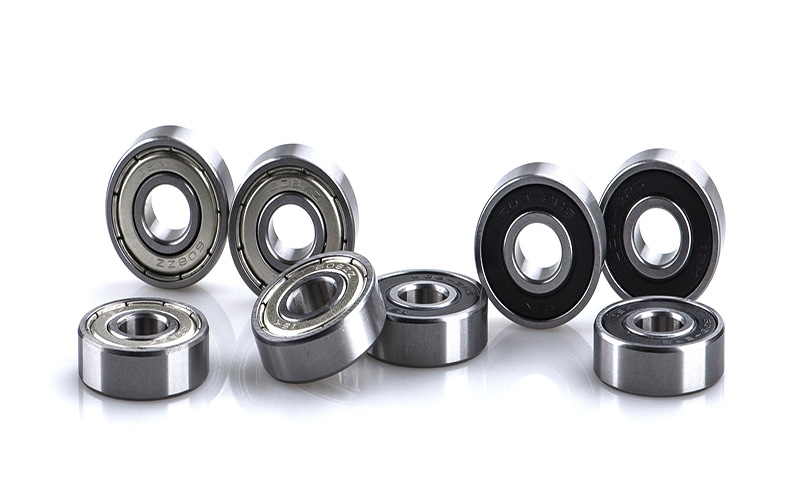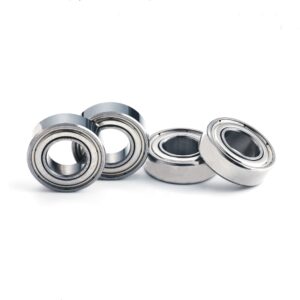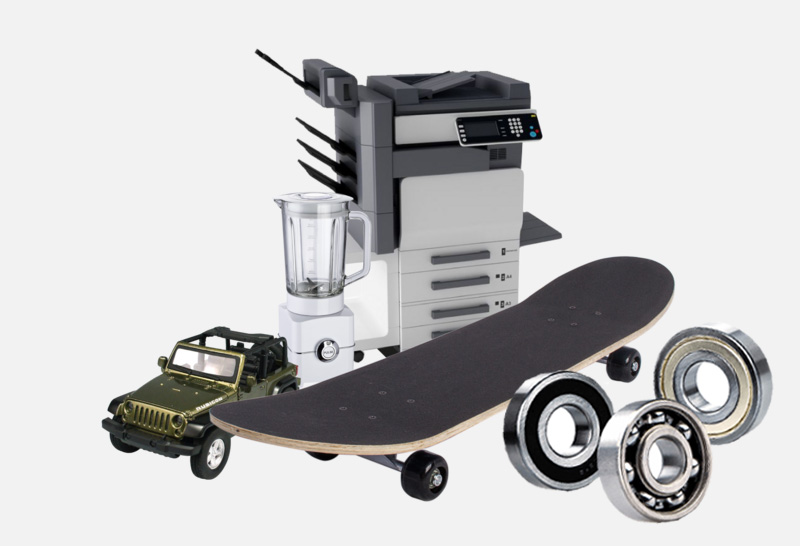Miniature Deep Groove Ball Bearings: Small Size, Big Performance
Miniature deep groove ball bearings refer to the metric series of outer diameter less than 9mm or inch series of outer diameter less than 9.525mm of various types of bearings. The main materials include carbon steel, bearing steel, stainless steel, plastics and ceramics, etc., of which the smallest inner diameter can be 0.6mm and the general inner diameter of 1mm more.
Miniature deep groove ball bearings have high precision, high speed, low noise and other excellent performance. These performance characteristics make the equipment in the operation process more smooth, more precise and more efficient. In aerospace, medical equipment, robotics and other high-precision requirements of the field, the application of miniature bearings can significantly improve the accuracy and reliability of the equipment, to ensure that the equipment in extreme working conditions can also maintain stable performance.

Types of Miniature Deep Groove Ball Bearings
Inch Size Miniature Ball Bearings
Inch-size miniature ball bearings are small ball bearings that use the imperial system of measurement to define their dimensions. These bearings are more commonly used in industrial applications, especially in North America and some countries that have traditionally used the Imperial system, especially where compatibility with existing Imperial equipment is required. The inside diameter, outside diameter and width of these bearings, are usually expressed in inches or fractions of an inch, such as 1/8 inch or 1/4 inch.

Inch Size Flanged Ball Bearings
Inch-size flanged ball bearings are specially designed ball bearings with an outer ring that has an extended edge or “flange” measured in inches. Commonly used in mechanical applications with inch systems where a simplified mounting process or increased axial stability is required, this flange design provides additional support area, making the bearing easier to mount and locate while also being able to withstand higher axial loads.

Metric Size Flanged Ball Bearings
Metric-size flanged ball bearings are a special type of ball bearing with an outer ring with an extended edge or “flange”, the dimensions of which are marked in millimeters. This design is widely used in a variety of precision machinery and industrial equipment around the world, especially in metric system application scenarios that require high-precision positioning and enhanced axial support, as it not only simplifies the mounting process but also provides an additional support area that enables the bearing to withstand axial loads better.
Metric Size Miniature Ball Bearings
Metric miniature ball bearings are small ball bearings whose dimensions are defined using a metric measurement system. These bearings are easier to standardize and use around the world, especially in applications that require miniaturized components, such as precision instruments, medical equipment, and small electronics, because their inner diameter, outer diameter, and width are usually specified in millimeters, such as 3 mm, 4 mm or 5 mm.
Miniature Bearing Dimensions and Specifications
Common Size Ranges
A common size range for miniature bearings is an inside diameter of less than 9mm (metric series) or an outside diameter of less than 9.525mm (inch series).
Smallest Bearing Size
The minimum dimensions of miniature bearings are 0.6mm inner diameter, 2.0mm outer diameter, and 0.8mm thickness.
Custom Miniature Bearings
The dimensions of miniature bearings usually include inner diameter, outer diameter, and width (or thickness). Customers can provide precise size requirements according to specific needs, such as an inner diameter of 1mm, outer diameter of 5mm, width of 2mm and so on.
Common miniature bearings size ranges such as outside diameters less than 9mm (metric series) or less than 9.525mm (inch series). However, the specific size can be flexibly customized according to the demand.
Features of Miniature Deep Groove Ball Bearings
Applications of Miniature Deep Groove Ball Bearings
Miniature Bearings for High-Speed Applications
- These bearings are used in:
Precision machinery and automation equipment, such as semiconductor manufacturing equipment, precision machining equipment, optical equipment, and other automation equipment. - Micro-motor and stepping-motor.
- Electronic products like hard disk drives, printers, digital cameras, and other electronic products.
- Also, various types of instrumentation like optical instruments and sensors.
Precision Miniature Bearings
Miniature bearings are characterized by high precision, low noise, and high rotational stability, which can meet the strict requirements of precision instruments for bearing performance.
Miniature bearings in precision instruments are used in aerospace, such as gyroscopes, navigation systems, and other precision instruments; industrial automation, such as flow meters, manometers, and other instruments; medical equipment, such as dental drills, endoscopes, and other rotating parts species.
Hobby Bearings
Miniature bearings provide critical support for all types of modeling and sports equipment due to their small size, compact structure, and excellent performance. They are widely used in the hobby and model-making field; the main applications are:
- Rotating parts such as wheels and propellers of remote-controlled racing cars, flying machines, etc., to reduce friction, lower noise, and enhance the overall performance of the equipment.
- They support and transfer the rotating parts inside the precision mechanical models to ensure that the models can perform precise movements and actions.
- Model airplanes: Miniature bearings are often used to support and transfer a load of rotating parts, such as wings, propellers, etc., to ensure that the airplane maintains stable and efficient operation in the flight process.
- Model vehicles: Minimal bearings are used in the key parts of wheels and transmission systems of RC cars and model racing cars to reduce friction and improve rotation efficiency.
- Model ships: miniature bearings are usually installed in the propeller, rudder, and other key parts to support and transfer the rotational force to ensure that the model ships can have stable navigation and accurate control of the direction.
Selecting the Right Miniature Deep Groove Ball Bearings
-
Speed Requirement
-
Bearing type: ball bearings have higher limiting speed and rotational accuracy than roller bearings, so ball bearings should be preferred at high speeds. Different types of bearings have different limiting speeds, so you need to choose the right type according to the specific application scenario.
-
Size and structure: under the condition of the same inner diameter, the smaller the outer diameter is, the smaller the rolling body is, the smaller the centrifugal inertia force added by the rolling body on the peripheral raceway during the operation, and thus suitable for working at a higher speed. Therefore, the high speed is suitable for the same-diameter series in the smaller-diameter bearings. If the bearing capacity of a single bearing can not be met, the requirements can be considered and installed with the same bearing or a wide series of bearings.
-
Cage material and structure: The material and structure of the cage have a great influence on the speed of the bearing. Solid cage than stamping cage allows higher speed and bronze solid cage allows higher speed. On the higher speed of work occasions, suitable for the selection of deep groove ball bearings and other bearings; on the lower speed of work occasions, tapered roller bearings can be selected.
-
Lubrication: the limiting speed of the bearing depends on many factors, including the type and brand of lubricant. Some lubricants may have good performance but are not suitable for high-speed rotation.
-
Environmental Factor
-
Use conditions include speed, load, ambient temperature humidity, and so on.
-
Selection of the appropriate lubricant can reduce friction and wear. 3.
-
contaminant protection measures (such as the use of sealed bearings or filters, etc.) to prevent the entry of small particles and foreign matter into the bearings.
-
Excessive temperature, humidity, or corrosive environment will affect the service life of bearings. According to the characteristics of the working environment take appropriate measures, such as strengthening heat dissipation, moisture, corrosion and so on.
Manufacturers and Suppliers of Miniature Deep Groove Ball Bearings
-
SKF (SKF): Founded in 1907 in Sweden, SKF is the world’s leading supplier of rolling bearings, housings, bearing units, seals, lubrication systems, condition monitoring, drives, and motion control products. SKF provides more than 20,000 standard bearing products covering various types, including rolling bearings, linear bearings, plain bearings, bearing housings, ball and roller screws, etc., and provides components for textile machinery, machine tools, and other precision equipment.
-
Schaeffler (FAG): Germany’s well-known brand, belonging to the German Schaeffler Group, known for its high precision and high reliability.FAG bearings are widely used in machine tool spindles and other fields, and its new X-life bearings have won global acclaim for their high speed, high precision, long life, etc. The outstanding features of FAG bearings include high reliability, compact size, strong load-carrying capacity, high quality, high reliability, high speed, high precision, high precision, high precision, high precision, high reliability, high precision, and high reliability. The outstanding features of FAG bearings include high reliability, compact size, strong load-carrying capacity, high precision guiding performance, low friction, high-temperature resistance, wear resistance, and so on.
-
Timken (TIMKEN): originated from the United States, widely used in automobiles, railroads, steel, machine tools, aviation, construction machinery, agriculture, and other fields. The steel used by Timken is of excellent quality and is one of the best clean steel in the world. As the world’s largest manufacturer of tapered roller bearings, Timken enjoys a high position in the manufacturing industry.
-
Renben Group Co., Ltd: Founded in 1991, Renben Group is a professional bearing manufacturer, and is also involved in commercial supermarkets, mechanical and electrical trade, and other industries. Reuben Group is the leader of China’s bearing industry through investment, mergers and acquisitions, and other means of continuous development and growth.
-
Luoxia (LYC): Founded in 1954, Luoxia is one of the 156 key projects during China’s First Five-Year Plan. After years of construction and development, LYC has become one of the comprehensive bearing manufacturers with the largest production scale and the strongest supporting service capacity in China’s bearing industry.
-
TFL, located in Jinan City, Shandong Province, is a professional bearing manufacturer, providing bearing products for all kinds of customers, covering a variety of bearing types, with high quality, cost-effectiveness, reliability and other advantages.
Maintenance and Care of Miniature Bearings
-
Appearance Inspection: Regularly check the appearance of the bearings to see if there are cracks, wear, corrosion or grease leakage. All these phenomena may be signals that the bearings need to be replaced.
-
Lubrication condition: Check the lubrication condition of the bearings to ensure that the grease or lubricant is sufficient and free from contamination. If the lubrication is poor, should be timely supplement or replacement of lubricants, and pay attention to the performance of the bearing changes. 3.
-
Accuracy testing: For equipment that requires a high-precision operation, the bearings can be tested for accuracy on a regular basis. If the precision of the bearing decreases and cannot meet the requirements of the equipment, it should be replaced in time.

